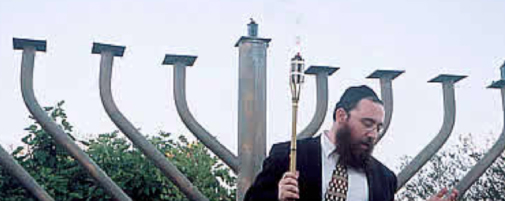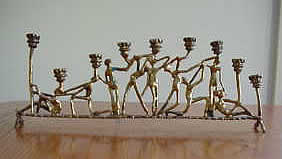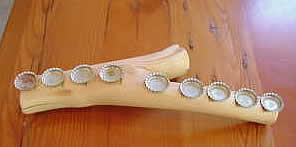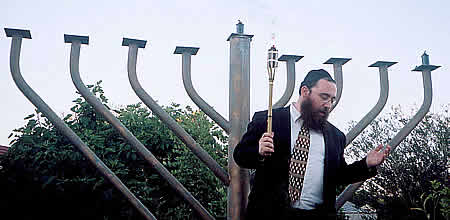
The Festival of Lights
This display has been curated for Chanukah using objects loaned from members of the Jewish community. The objects show the diversity of styles and materials of the menorah, and the idiosyncratic taste of the lenders of the items. Many more could be exhibited, however, they are being used for Chanukah, which lasts from the 9th to the 16th of December 2001. I have deliberately not cleaned the wax off some of the items to indicate that they are objects actually used for the ritual lighting for Chanukah.
The Hebrew word Chanukah means dedication. Chanukah celebrates events that took place about 2,300 years ago in the land of Judea, now Israel.
During that time, Judea was ruled by the Syrians. The Syrian-Greek King Antiochus ordered the Jewish people to reject their religion and assimilate into Greek culture. He outlawed Jewish observance in an attempt to erode the foundation of Jewish life and practice.
Collection A. Simmons, Figurative brass menorah probably representing the Maccabee’s
In response to this threat to Jewish life, a band of Jews formed an army and fled to the hills of Judea. They took as their name the word Maccabee, meaning hammer. Led by Matitiyahu, and later his son Judah, this small band of pious Jews led guerilla warfare against the Syrian army and after several years of fighting, defeated the more powerful Syrian forces.
The Maccabees entered Jerusalem in 164 BCE to reclaim the Temple for the Jewish people. The Temple had been taken over by the Syrians; it was filled with Greek statues and symbols. They cleansed and repaired the Temple and re-dedicated it once more to the worship of one God, on the 25th day of the Hebrew month of Kislev. When it came time to re-light the Menorah, the eternal light present in every Jewish house of worship, they could only find one small jar of oil, enough for one day. Miraculously, the small jar of oil burned for 8 days until a new supply could be specially prepared and blessed by a religious leader.
Collection E. Cohen, Hand-made menorah, Australian Bottle-brush and beer tops
Since then, Jewish families celebrate Chanukah, to commemorate this historic victory and the miracle of the oil.
Rabbi Engel, Adelaide Hebrew Congregation, lights the outdoor menorah, 9 December 2001
The Dreidel (spinning top; Sivivon in Modern Hebrew) During Syrian rule, Jews were imprisoned for studying the Torah, and while in prison, they would gather to play dreidel. Under the guise of play, they would engage in Torah discussions and thus defy their persecutors.
Collection J. Cohen, Hand-painted dreidel made from olive wood, Israel Collection M. Trubik, Brass menorah from the Old City in Jerusalem.
A dreidel has four sides with one Hebrew letter on each side. Each of these letters begins a word:
o Nun – the 1st letter of the word nes which means ‘miracle’
o Gimmel – the 1st letter of gadol which means ‘great’
o Hey – the 1st letter of haya which means ‘was’
o Shin – the 1st letter of sham which means ‘there’
They form an acronym for the phrase ‘Neis gadol hayah sham’ – A great miracle happened there. Mystical Kabbalah teachings puts forward another dimension: The letters on the sides of the dreidel represent the four different historical empires, Babylonian, Persian, Greek and Roman, who tried to destroy the Jewish people.






Recent Comments